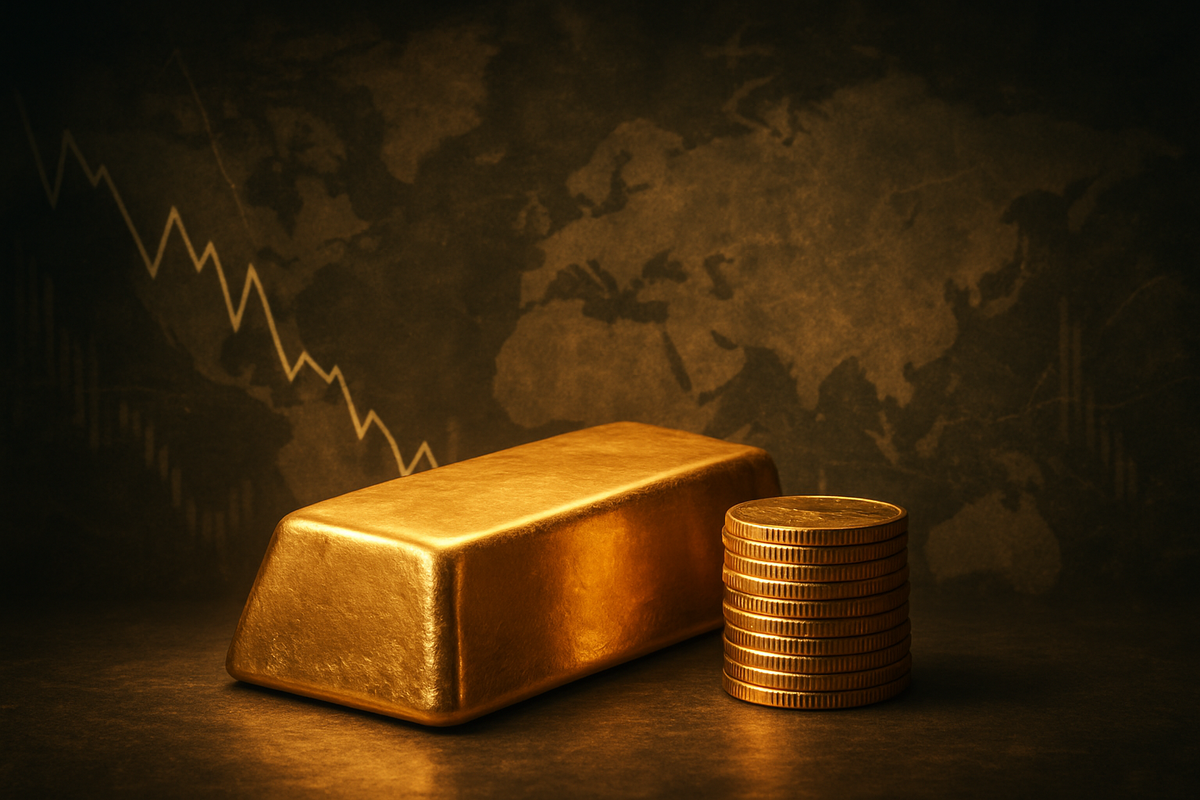
The global financial landscape is currently grappling with a potent mix of economic uncertainties and geopolitical tensions, a scenario that has historically proven to be a fertile ground for gold. The precious metal has recently experienced a remarkable surge, catapulting to an all-time high of $4,381.58 per troy ounce in October 2025, representing an astounding 49% increase over the past year. As of early November 2025, it hovers around $3,963.58 USD/t.oz., firmly reasserting its role as the quintessential safe-haven asset.
This dramatic ascent is not merely a fleeting market anomaly but rather a direct reflection of a pervasive "risk-off" sentiment gripping global markets. Investors, increasingly wary of overstretched equity valuations, particularly in the technology sector, and navigating a complex macroeconomic environment characterized by fluctuating US payrolls data and significant stock market sell-offs, are flocking to gold as a bulwark against potential financial instability. The implications are far-reaching, from driving up jewelry costs and stimulating the second-hand gold market to signaling deeper anxieties within the global economy.
A Deep Dive into Gold's Unprecedented Ascent
The current surge in gold prices is a complex tapestry woven from a series of interconnected global events and macroeconomic shifts, signaling a profound recalibration of investor sentiment. Beginning in early 2024, gold embarked on a consistent upward trajectory, fueled initially by aggressive and sustained purchasing from global central banks, particularly those in emerging economies like China, Turkey, and India. These institutions sought to diversify their reserves away from the U.S. dollar amidst lingering geopolitical risks, including the Russia-Ukraine conflict and escalating Middle Eastern tensions. By September 2024, gold had reached an all-time high of $2,685.49 per troy ounce, a precursor to the dramatic rallies that would follow.
The timeline of gold's recent rally is punctuated by key economic data releases and significant shifts in equity markets. February 2025 saw gold breach the $2,900/oz mark, quickly followed by a breakthrough above the critical $3,000 per ounce threshold in March, marking a 13.6% gain for the year. April 2025 pushed the envelope further, with gold peaking at $3,500/oz. While the U.S. ADP National Employment Report on April 2, 2025, showing better-than-expected private sector job additions, caused a momentary dip, gold swiftly rebounded as traders refocused on broader global instabilities. Conversely, an unexpected fall in U.S. private payrolls in June, reported on July 2, 2025, saw gold prices rise by 0.3% as expectations for Federal Reserve rate reductions intensified. The most impactful jobs data came on August 1, 2025, when a "shockingly weak" U.S. jobs report for July (only 73,000 jobs added against a 100,000 forecast) triggered a dramatic 1.73% surge in gold futures, reflecting a widespread rush to safety and bolstered hopes for accelerated Fed rate cuts. This trend continued into September, with underwhelming nonfarm payrolls data on September 5, 2025, propelling gold to $3,578.22 an ounce amid robust safe-haven demand.
A significant driver of this flight to safety has been the growing apprehension surrounding equity valuations, particularly within the burgeoning Artificial Intelligence (AI) and technology sectors. On January 27, 2025, gold prices initially dipped as global stocks, including giants like Nvidia Corp. (NASDAQ: NVDA) and ASML Holding NV (NASDAQ: ASML), experienced sharp declines amid concerns over potential challenges to U.S. dominance in AI. However, this dip was short-lived, with gold quickly resuming its upward trajectory as investors sought refuge from market volatility. More recently, in October 2025, gold soared past $4,000 per ounce, reaching its all-time high of $4,381.58. During this period, prominent figures like Goldman Sachs (NYSE: GS) CEO David Solomon issued stark warnings on October 3, 2025, about a possible 20% market correction in AI-driven stocks, drawing parallels to the Dotcom Bubble. These concerns were reiterated on November 5, 2025, by Solomon and Morgan Stanley (NYSE: MS) boss Ted Pick, as technology companies spearheaded a sharp sell-off across Asian markets and Nasdaq 100 futures, further solidifying gold's appeal as a safe haven. Despite a slowdown in central bank net purchases in Q3 2025, as reported by the World Gold Council, the cumulative effect of these factors has firmly entrenched gold as the asset of choice for investors navigating an increasingly uncertain economic landscape.
Companies That Might Win or Lose from Gold's Ascent
The dramatic surge in gold prices creates a distinct bifurcation in the market, presenting significant opportunities for some companies while posing considerable challenges for others. The primary beneficiaries are, unsurprisingly, gold mining companies. These firms, whose core business involves extracting gold from the earth, see their profit margins expand significantly as the price of their primary commodity rises. Companies like Barrick Gold Corporation (NYSE: GOLD), Newmont Corporation (NYSE: NEM), and Agnico Eagle Mines Limited (NYSE: AEM) are poised to experience substantial revenue growth and improved profitability. Higher gold prices allow them to monetize previously uneconomical reserves, potentially increasing their overall asset value and extending mine life. Furthermore, junior exploration companies with promising gold deposits could see increased interest and investment, as the economics of developing new mines become more attractive.
Conversely, the rising cost of gold impacts industries that rely on the metal as a raw material. Jewelry manufacturers and retailers face increased input costs, which they must either absorb, thereby squeezing margins, or pass on to consumers, potentially impacting demand. Companies like Tiffany & Co. (NYSE: TIF), a subsidiary of LVMH Moët Hennessy Louis Vuitton (EPA: LVMH), and other luxury goods brands, could see reduced sales volumes for gold-intensive products or be forced to innovate with lighter designs or alternative materials to maintain affordability. The surge in prices has already spurred growth in the second-hand gold market, suggesting a shift in consumer behavior away from new purchases towards recycling existing gold.
Beyond direct exposure, the macroeconomic conditions fueling gold's rise—namely, global risk aversion, concerns over equity valuations, and economic uncertainty—can have broader implications for the corporate landscape. Companies heavily reliant on robust consumer spending or stable economic growth, particularly those in discretionary retail, travel, and hospitality sectors, may face headwinds as consumers tighten their belts and economic sentiment sours. Furthermore, technology companies, especially those with high valuations in the "AI bubble" category, as warned by institutions like Goldman Sachs (NYSE: GS) and Morgan Stanley (NYSE: MS), could face significant corrections, impacting their stock performance and investment prospects. While not directly linked to gold, the flight to safety it represents often comes at the expense of riskier assets, including growth-oriented equities.
Financial institutions with significant exposure to these volatile equity markets could also face challenges. While investment banks like Goldman Sachs and Morgan Stanley provide diverse services, a prolonged market correction could impact their trading revenues, asset management fees, and underwriting activities. However, some financial players might benefit from increased volatility, as it can drive trading activity and demand for hedging instruments. Ultimately, the companies best positioned to weather this environment are those with strong balance sheets, diversified revenue streams, and a clear strategic response to shifting market dynamics, whether by capitalizing on the gold boom or by adapting to a more risk-averse global economy.
Wider Significance: A Barometer of Global Unease
The current surge in gold prices is far more than a simple commodity rally; it serves as a potent barometer of deep-seated global unease, reflecting a confluence of macroeconomic shifts, geopolitical tensions, and evolving investment paradigms. This event fits squarely into a broader industry trend of de-dollarization efforts by central banks and a renewed focus on tangible assets in an era of unprecedented digital and financial uncertainty. The aggressive accumulation of gold by central banks, particularly from emerging economies, highlights a strategic pivot away from reliance on the U.S. dollar, driven by concerns over potential sanctions, currency debasement, and a desire for greater financial autonomy. This institutional demand provides a robust floor for gold prices, distinguishing the current rally from speculative bubbles of the past.
The ripple effects of this gold surge are multifaceted. For competitors and partners in the precious metals space, such as silver and platinum, gold's performance can often act as a leading indicator, potentially drawing investor attention to the broader precious metals complex. However, gold's unique safe-haven status means its rallies are often more pronounced during periods of extreme risk aversion. The emphasis on gold also underscores a shift in investor preference away from traditional growth assets, particularly in technology, towards value preservation. This could prompt a re-evaluation of portfolio allocations across the board, potentially diverting capital from sectors perceived as overvalued into more defensive assets.
From a regulatory and policy perspective, sustained high gold prices could influence monetary policy decisions. If the flight to gold signals persistent inflation concerns or a lack of confidence in fiat currencies, central banks might face increased pressure to address these underlying issues, potentially through adjustments to interest rates or quantitative easing programs. The ongoing U.S. government shutdown, for instance, has already highlighted the importance of private payroll data, creating additional market jitters that can sometimes benefit gold. Furthermore, the increased scrutiny of "AI bubbles" by financial regulators and institutions like Goldman Sachs and Morgan Stanley could lead to enhanced oversight of speculative markets, aimed at preventing systemic risks.
Historically, gold rallies have often coincided with periods of significant global stress. Comparisons can be drawn to the 1970s, an era marked by high inflation, oil crises, and geopolitical instability, which saw gold prices soar. More recently, the aftermath of the 2008 financial crisis and periods of heightened trade tensions or pandemic-induced uncertainty have also driven gold demand. The key difference now is the added dimension of a potential "AI bubble" in equities, which introduces a new layer of systemic risk. Unlike previous cycles, the current environment also features a more fragmented geopolitical landscape and an aggressive central bank buying spree, suggesting that gold's role as a strategic asset is being fundamentally re-evaluated by nation-states, not just individual investors. This collective institutional demand provides a powerful and potentially more enduring tailwind for gold prices than seen in many past rallies.
What Comes Next: Navigating the Golden Horizon
The path forward for gold prices appears to be paved with continued uncertainty, yet punctuated by distinct short-term and long-term possibilities. In the short term, gold's trajectory will likely remain highly sensitive to incoming macroeconomic data, particularly U.S. employment figures and inflation reports, as these will directly influence the Federal Reserve's monetary policy decisions. Any signs of persistent economic weakness or renewed inflationary pressures could reinforce expectations for further interest rate cuts, thereby boosting gold's appeal by lowering the opportunity cost of holding the non-yielding asset. Conversely, stronger-than-expected economic data or a more hawkish stance from the Fed could introduce headwinds, potentially leading to a temporary correction from its current elevated levels. Geopolitical developments, especially in volatile regions, will also continue to serve as immediate catalysts for safe-haven flows.
Looking into the long term, the fundamental drivers underpinning gold's surge are unlikely to dissipate quickly. The trend of central bank diversification away from the U.S. dollar, fueled by geopolitical considerations and a desire for reserve stability, is a structural shift that will likely sustain institutional demand for gold for years to come. Furthermore, if concerns about global government debt levels, currency debasement, and the potential for a prolonged period of economic stagnation or "stagflation" persist, gold's intrinsic value as a store of wealth will only grow. Potential strategic pivots for investors include increasing their allocation to gold and gold-related assets as a core component of a diversified portfolio, rather than merely a tactical trade.
Market opportunities may emerge for gold mining companies that can efficiently expand production or develop new reserves, capitalizing on higher prices and improved project economics. Companies in the precious metals streaming and royalty business could also see increased deal flow as miners seek financing. Challenges, however, include potential regulatory hurdles for new mining projects, rising operational costs, and the inherent volatility of commodity markets. For the broader market, a sustained flight to gold could signal a deeper, more prolonged period of risk aversion, forcing companies across various sectors to adapt to potentially lower growth environments and increased scrutiny of their valuations.
Potential scenarios range from a continued, albeit more moderated, ascent for gold if global economic and geopolitical uncertainties remain high, to a more significant correction if central banks pivot aggressively towards tighter monetary policies or if geopolitical tensions unexpectedly de-escalate. Another scenario involves gold stabilizing at a new, higher baseline, reflecting its re-established role as a foundational asset in a turbulent world. Investors should prepare for continued volatility but recognize the underlying structural shifts that are likely to provide long-term support for the precious metal.
Wrap-up: Gold's Enduring Appeal in a Volatile World
The recent, dramatic surge in gold prices to unprecedented highs serves as a critical summary of key takeaways from the current global financial landscape: a pervasive "risk-off" sentiment, driven by anxieties over equity market valuations—particularly the perceived "AI bubble"—and exacerbated by macroeconomic uncertainties such as fluctuating U.S. payrolls data and persistent geopolitical tensions. Gold's rally underscores its enduring role as the ultimate safe-haven asset, a tangible store of value that investors flock to when confidence in traditional financial instruments wanes. The consistent demand from central banks, particularly from emerging markets seeking diversification, has provided a powerful and structural underpinning to this rally, distinguishing it from purely speculative movements.
Assessing the market moving forward, it is clear that the factors fueling gold's ascent are not fleeting. While short-term corrections are always possible, especially after such a rapid climb, the fundamental drivers—including global de-dollarization efforts, persistent inflation concerns, high government debt levels, and ongoing geopolitical instability—suggest a prolonged period of support for gold. The warnings from institutions like Goldman Sachs (NYSE: GS) and Morgan Stanley (NYSE: MS) regarding potential market corrections in AI-driven equities further reinforce the narrative of a market seeking stability amidst speculative excesses.
The final thoughts on significance and lasting impact point to a re-evaluation of gold's position in global finance. It is no longer just a hedge against inflation or a crisis asset; it is increasingly viewed as a strategic reserve asset by nations and a core portfolio component by savvy investors. This re-entrenchment reflects a deeper distrust in traditional financial systems and a growing preference for assets with intrinsic value. The lasting impact will likely be a higher baseline for gold prices and a continued emphasis on diversification and risk management across all investment portfolios.
What investors should watch for in coming months includes the Federal Reserve's stance on interest rates, particularly any shifts in their forward guidance following economic data releases. Key U.S. employment and inflation reports will be crucial. Investors should also monitor geopolitical developments closely, as any escalation or de-escalation of tensions could significantly impact gold prices. Furthermore, keep an eye on central bank gold purchasing trends, as any sustained increase or decrease could signal broader shifts in global monetary policy and reserve management strategies. Finally, the performance of technology and AI-related equities will be a key indicator of overall market sentiment and risk appetite; a significant correction in these areas would almost certainly provide further impetus for gold.
This content is intended for informational purposes only and is not financial advice





